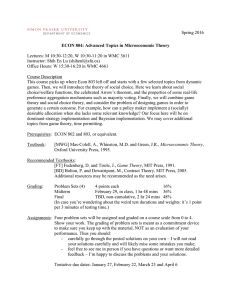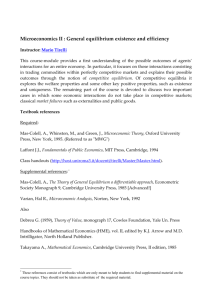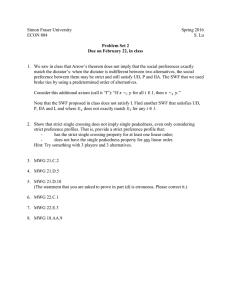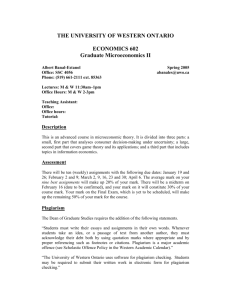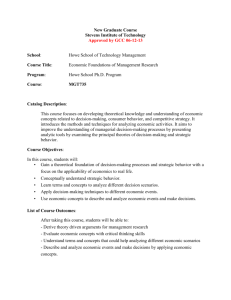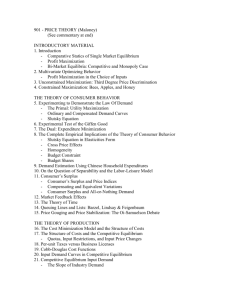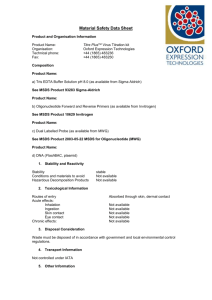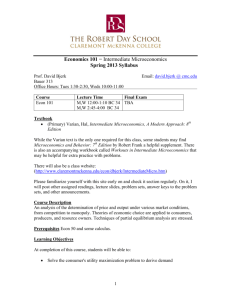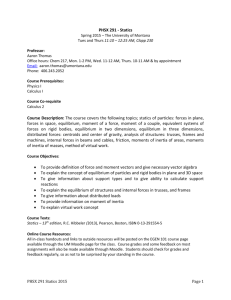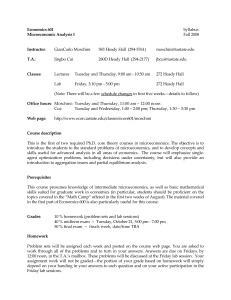Economics 804: Microeconomics I Fall 2011
advertisement
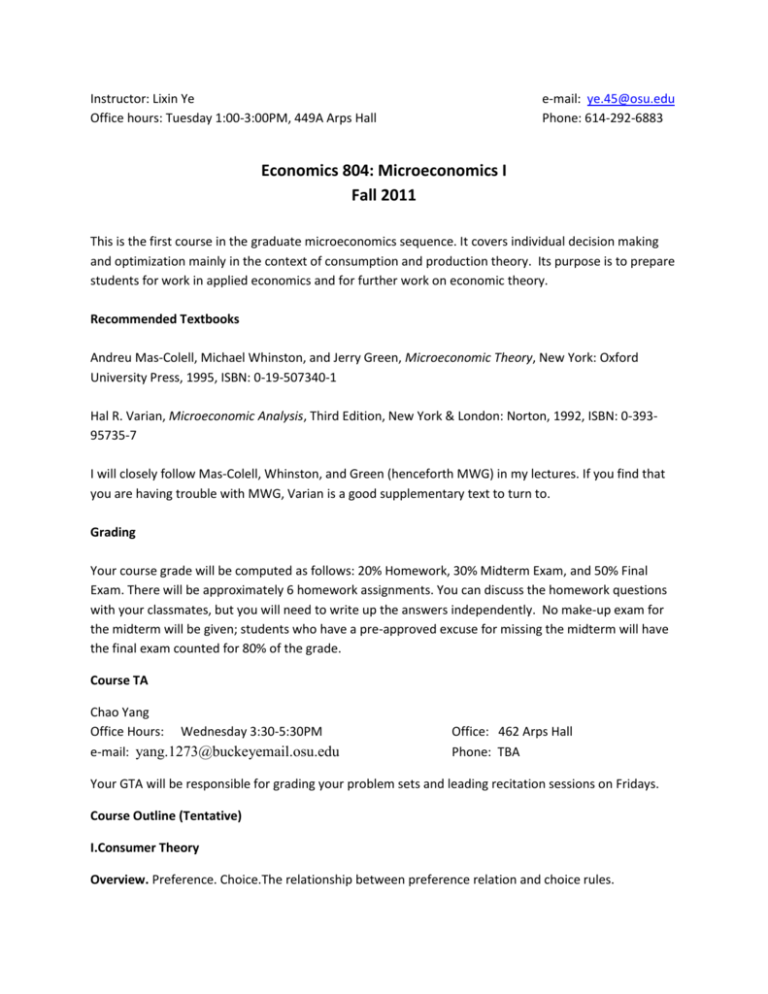
Instructor: Lixin Ye Office hours: Tuesday 1:00-3:00PM, 449A Arps Hall e-mail: ye.45@osu.edu Phone: 614-292-6883 Economics 804: Microeconomics I Fall 2011 This is the first course in the graduate microeconomics sequence. It covers individual decision making and optimization mainly in the context of consumption and production theory. Its purpose is to prepare students for work in applied economics and for further work on economic theory. Recommended Textbooks Andreu Mas-Colell, Michael Whinston, and Jerry Green, Microeconomic Theory, New York: Oxford University Press, 1995, ISBN: 0-19-507340-1 Hal R. Varian, Microeconomic Analysis, Third Edition, New York & London: Norton, 1992, ISBN: 0-39395735-7 I will closely follow Mas-Colell, Whinston, and Green (henceforth MWG) in my lectures. If you find that you are having trouble with MWG, Varian is a good supplementary text to turn to. Grading Your course grade will be computed as follows: 20% Homework, 30% Midterm Exam, and 50% Final Exam. There will be approximately 6 homework assignments. You can discuss the homework questions with your classmates, but you will need to write up the answers independently. No make-up exam for the midterm will be given; students who have a pre-approved excuse for missing the midterm will have the final exam counted for 80% of the grade. Course TA Chao Yang Office Hours: Wednesday 3:30-5:30PM e-mail: yang.1273@buckeyemail.osu.edu Office: 462 Arps Hall Phone: TBA Your GTA will be responsible for grading your problem sets and leading recitation sessions on Fridays. Course Outline (Tentative) I.Consumer Theory Overview. Preference. Choice.The relationship between preference relation and choice rules. MWG. chapter 1. Consumer Choice. Demand functions and comparative statics. The weak axioms of revealed preference and the law of demand. MWG: chapter 2. Varian: chapter 8. Classical Demand Theory. Axioms of consumer preferences. Existence of a utility function. The utility maximization problem (UMP). Properties of Walrasian demand functions. Value function and the Envelope Theorem. Indirect utility function. Roy’s identity. The expenditure minimization problem (EMP). The expenditure function. Shephard’s lemma. Properties of Hicksian demand functions. The compensated law of demand. Relationship between UMP and EMP. The Slutsky equation: substitution and income effects. The law of demand. Welfare evaluation of economic change. Equivalent variation and compensating variation. Quasilinear utility. Consumer surplus. MWG: chapter 3. Varian: chapters 7, 9, 10. Duality. Hyperplanes and halfspaces. Separating and supporting hyperplane theorems. Duality results for the expenditure function. The implications of convexity and monotonicity. Recovering the utility function from an expenditure function. Recovering the direct utility function from an indirect utility function. MWG: chapter 3. II: Producer Theory Technology. Production possibility set. Input requirement set. Isoquant. Production function. Transformation function. Regularity and curvature assumptions. Technical rate of substitution. Elasticity of substitution. Returns to scale. Efficiency and profit maximization. Homogeneity and homotheticity. MWG: chapter 5. Varian: chapter 1. Profit Maximization and the Profit Function. The profit maximization problem. Production function. Unconstrained optimization applied to profit maximization. FOCs for interior and corner solutions. SOCs and curvature. Input demands and output supply. Properties of demand and supply functions. Comparative statics using FOCs. Definition and properties of the profit function: monotonicity, homogeneity, convexity, and continuity. Hotelling's Lemma and the Envelope Theorem. Properties of input demands and output supply. Comparative statics with the profit function. MWG: chapter 5. Varian: chapter 3. Cost Minimization and the Cost Function. Constrained optimization and the cost minimization problem. FOCs for interior and corner solutions. SOCs and curvature. Conditional factor demands. Comparative statics. Definition and properties of the cost function: monotonicity, homogeneity, concavity, and continuity. Shephard's lemma and the Envelope Theorem. Comparative statics with the cost function. Cost function and output. Marginal cost and average cost. Returns to scale. Homotheticity and homogeneity. Profit maximization with the cost function. Fixed costs, variable costs, and sunk costs. Long-run and short-run. Review of duality and parallels with consumer theory. Geometry of duality: isoquants, isocosts, and factor demands. MWG: chapter 5. Varian: chapter 4. III: Partial Equilibrium Competitive Markets. Features of perfect competition. Definition of equilibrium and partial equilibrium. Industry supply functions in the short run. Industry (market) demand function. Equilibrium in the short run, existence and uniqueness. Welfare analysis in partial equilibrium. Demand with quasilinear utility and Marshallian surplus. Pareto efficiency. First and second welfare theorems in a partial equilibrium context. Welfare effects of taxation. Free entry and long-run equilibrium. MWG: chapter 10. Varian: chapter 13. Monopoly. The monopolist’s profit maximization problem. Comparative statics of a cost change. Welfare effects of a monopoly; comparison with competitive equilibrium. Regulating a monopoly: price ceilings and taxes/subsidies. First-degree (perfect) price discrimination. Second-degree price discrimination (nonlinear pricing).Third-degree (multimarket) price discrimination. MWG: chapter 12. Varian: chapter 14. IV: Uncertainty and Risk Aversion Elements of Choice under Uncertainty. Lotteries. Preferences over lotteries. The Independence Axiom and the Expected Utility (EU) theorem. The Allais paradox. EU representations for continuous random variables. Risk aversion: Jensen's inequality and concavity of the Bernoulli utility function. Certainty equivalent and the risk premium. The Arrow-Pratt coefficient of absolute risk aversion. The coefficient or relative risk aversion. MWG: chapter 6. Varian: chapter 11. Selected Applications. A simple insurance model. A simple portfolio model. Comparative statics in the simple portfolio model: the effects of initial wealth and risk attitudes (decreasing absolute risk aversion; decreasing relative risk aversion). MWG: chapter 6. Varian: chapter 11. Students with disabilities that have been certified by the Office for Disability Services will be appropriately accommodated, and should inform the instructor as soon as possible of their needs. The Office for Disability Services is located in 150 Pomerene Hall, 1760 Neil Avenue; telephone 292-3307, TDD 292-0901; http://www.ods.ohio-state.edu/.
